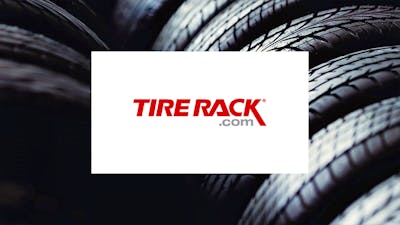Best Tires for Nissan Rogue
The Nissan Rogue is a popular crossover with some excellent tire options you can choose from to meet your needs, rather than Nissan’s. While the factory tires for the Nissan Rogue are just fine, they might not meet your specific needs as a driver.
Get the Best Deals on Tires
Here is an overview of the best tire options for the Nissan Rogue crossover. We’ve organized our recommendations by tire size, and by price. We think we’ve got something that will work for your Nissan Rogue, whether you’re Ebenezer Scrooge, Scrooge McDuck or somewhere in between.
Have an older Nissan Rogue? See tire sizes for previous years.
Best 17-inch Tires for the Nissan Rogue (S & SV):
- Continental TrueContact - Best budget tire
- Yokohama Geolandar GO55 - Best mid-priced tire
- Michelin Premier LTX - Best superior tire
Best 18-inch Tires for the Nissan Rogue (S & SV):
- Riken Raptor HR - Best budget tire
- Goodyear Assurance ComforTred - Best mid-priced tire
- Michelin Premier LTX - Best superior tire
Best 19-inch Tires for the Nissan Rogue (SL):
- Continental TrueContact - Best budget tire
- Goodyear Assurance ComforTred - Best mid-priced tire
- Michelin Premier LTX - Best superior tire
Shop Tires Online and Save
Online tire prices are usually less than in store

Original Equipment Rogue Tires
The current generation Nissan Rogue crossover is sold in many trims, but with just three different tire sizes. The combinations are too numerous to list, so be sure to start by checking your vehicle's tire size before you shop. The size is shown on the side of every tire.
Here is a list of some of the original equipment tires this manufacturer has fitted to the Rogue:
- Bridgestone ECOPIA H/L 422 PLUS- (Most likely tire and that fitted to our 2019 Test Rogue)
- Yokohama GEOLANDAR G055
- Falken ZIEX ZE001 A/S
- Dunlop GRANDTREK ST30
- Goodyear ASSURANCE CS FUEL MAX7
- Kumho SOLUS KL21
- Hankook DYNAPRO HT RH12 - SIZE: 225/65R17
Top Replacement Tire Brands for Nissan Rogue
Our recommendations below are based on your preference for a budget-priced tire, one moderately priced, and one that may be the best overall touring all-season tire regardless of price. We also note which have a good “Eco” rating for fuel economy by the manufacturer.
Remember to verify which of the three sizes your Rogue has.
The tires on your Rogue are likely one of these three sizes:
- 225/65/R17 (With 17 being the wheel diameter. R means “radial tire”)
- 225/60/R18
- 225/55/R19
Here is the trim vs. possible tire size matrix for the Rogue:
- 17-inch (Rogue S, SV, and Rogue Hybrid SV, SL):
- 18-Inch (Rogue S, SV, Rogue Hybrid SL)
- 19-Inch (Rogue SL)
Here are Car Talk’s suggested tire picks based on the 18” wheel size:
- Budget 17-inch and 19-inch: Continental TrueContact - At about $115 this tire is a brand and model well known to crossover owners. It has a rating of UTQG: 800 A B which means top scores for all categories. Hybrid owners take note: In this size, the tire is also rated EcoPlus
- Budget 18-inch: Riken Raptor HR - At around $100, it may surprise you that this tire earns our minimum 4-start overage for owner reviews. This is not a brand name you may recognize, but when you tire is half the cost of the brand names, do you care? This tire features good overall specifications and a UTQG code of 520 A A. That means it has top scores for traction and temperature and an expected lifespan of more than 50,000 miles.
- Moderately Priced 17-inch: Yokohama Geolander G055 - One of the OEM picks by Nissan is this Yokohama with a UTQG rating of 740 A A. That means long life and great traction and temp ratings.
- Moderately Priced 18-inch and 19-inch: Goodyear Assurance ComforTred - The Assurance ComforTread is a middle-range tie in terms of pricing from a brand we all know very well. It has aUTGQ code of 740 A B meaning long life, great traction, and a good temperature rating. This tire does well in every category, but will likely be quieter than most of its peers.
- Cost-No-Object 17-, 18- and 19-inch: Michelin Premier LTX - Our research shows that there is one tire with solid owner ratings and great specifications that fits all three Nissan Rogue tire sizes - The Michelin Premier LTX. With a UTQG rating of 620 A A, this tire has a mid-range wear expectancy and great temp and traction scores. This tire also has a focus on wet and cold performance with a tread that changes its shape as it wears to keep the tire performing consistently.
When Should You Replace the Tires on Your Rogue?
There are two regular milestones that will suggest that it’s time to replace the tires, not only on your Nissan Rogue but any vehicle in your driveway: Time and Mileage.
Considering most drivers cover between 12,000 and 15,000 miles per year, the vast majority of Rogue owners are going to be past the mileage that their original equipment tires were intended to cover before they’ll go past the tire’s usable age.
The life of your tire can be somewhat predicted by its UTQG (Uniform Tire Quality Grade) rating. Tire manufacturers apply their own grades to tires for treadwear, traction, and temperature. When you’re researching tires online, a UTQG will come up next to the tire name in three digits and a number (ex. 500 A A).
You can glean a bit of info from the tires by reading this rating:
- 500 - The durability rating of a tire, compared to a control tire with a tread life of 100. To obtain a grade, tires run on a 640-kilometer course for 11,520 km. Every 1,280 km, the tread depth is measured, to provide a projected tread life. The higher the number, the longer the predicted tread life.
- A - This is the Traction rating of a tire, which indicates how well a tire stops in wet conditions. The highest letter grade is AA, followed by A, B, and C.
- A - The second letter in the UTQG is the Temperature rating, which indicates how well a tire holds up to extreme heat. A is the highest, followed by B and C.
- Original equipment Yokohama Geolander tires Nissan fits the Rogue earns a 700 AA UTGQ rating. Unless they are damaged, these tires could last as long as 70,000 miles before you need to replace them.
The other consideration is time. Each tire has a raised date code on the sidewall. The number begins with the letters “DOT” followed by 12 digits in three four-digit groups. The date code is the third group of four digits. To decipher the date of your tires, the first two digits represent the WEEK the tire was produced, and the second two digits represent the YEAR.
For example, if your tire’s date code is 3217, that indicates the tire was manufactured in the 37th week of 2017, or sometime between September 11 and 17th that year.
Once tires go beyond five years old, it’s time to consider replacing them. Tires are made up not just of rubber and steel or kevlar belts, but chemicals that help the tires resist UV rays, temperature changes and a lot of other environmental hazards. Those chemicals start to break down after five years or so, and the tires aren’t doing the job that they need to do.
See our recommendations for the Best Insurance for your Nissan Rogue
Why Not Replace with Original Nissan Equipment Tires?
There’s no harm in replacing your tires with the shoes it came with from the factory. However, depending on what kind of driver you are, there are significant reasons to purchase something different.
You only need to purchase ONE set of tires for your car every four years or so, depending on how much you drive. When an auto manufacturer purchases tires, they buy them by the hundreds of thousands. For the manufacturer, the decision to choose a supplier one brand or another comes down to a price point. For you, your consideration may be completely different. If you could get a tire that stopped 20 feet shorter for an additional $10 per tire over the original equipment, you’d probably do it. (At least we sure hope you would think your safety is worth an additional $40!) Similarly, if there was a tire that provided less road noise or longer tread life for a minimal investment overstock, chances are, you’d probably decide on the slightly more expensive tire.
Changing Nissan Rogue Tire Sizes
Depending on the year and model, you may be shopping tires to fit anything between 15-inch for older models to 18-inch wheels with various widths and sidewall sizes along the way. It is possible to change the wheel and tire sizes, but a general rule of thumb is to keep the total diameter of the wheel and tire the same. So, that means that downsizing an 18-inch wheel to a 17-inch wheel would include a proportionate upsizing of the tire sidewall to compensate.
Downsizing wheels has its advantages. Benefits include:
- Better ride quality – More rubber means more cushion for poor road conditions.
- Cost reduction – Big tires are expensive, so moving to a smaller wheel size will mean less costly tire purchases.
- Seasonal changes – Winter and snow tires are available for a larger selection of smaller wheel sizes and the narrower footprint will provide better traction.
- Off-road – Many people choose to downsize wheels for off-road use to increase the vehicle’s shock absorption capabilities and bump traction on loose surfaces.
On the other side of the coin, going up in wheel size has its benefits:
- Better handling – Slimmer profile tires make for less rubber to move around.
- Better looks – This one’s subjective, but many people feel that larger wheels look better than smaller wheels with more rubber.
- Better braking – Larger, wider wheels provide a bigger patch of rubber on the ground to slow the vehicle, reducing braking distance.
How to Read Tire Sizes
When reading tire sizes, it’s important to understand what the numbers mean. Let's use an all-season tire with a 235/65r17 103H specification as an example:
- 235 - indicates the width of the tire from one sidewall to the other in millimeters. This tire is 235 millimeters wide.
- 65 - indicates the aspect ratio, or sidewall height, as a percentage of the tire’s width. In this case, it’s 50 percent or of the tire’s width.
- R - means radial tires. Radials are the most common type of automotive tire and have fabric woven in at various angles with a tread that is strengthened with additional layers of rubber.
- 17 - indicates the wheel diameter.
- 103 - is the tire’s load rating.
- H - is the tire’s speed rating. V-rated tires have a maximum top speed of 130 mph.
You may have noticed that Nissan Rogue’s three tire sizes have different diameters and also different aspect ratios. Generally, automakers choose tires that have the same outer diameter. This allows them to have only one speedometer setting.
Now that you know what comes on the new Rogue and how to read the size numbers, let’s look at the different types of tires available to you. Depending on the type of driving you’re doing, where you live, and the weather, you have a variety of choices for tire types:
- Touring and All-season - tires provide a smooth ride, good wet and dry traction, decent winter traction, and longer tread life. These tires are acceptable for winter use but can’t be expected to provide the traction and stopping power than a dedicated winter tire can.
- Performance tires - are focused on providing confident handling, better wet and dry traction, and a sporty feel. Their higher grip and speed ratings come with a tradeoff of shortened tread life and reduced ride quality.
- All-terrain tires - are built to maximize off-road traction and provide good durability overall. Their construction means more noise and less comfort on the road, but winter traction and tread wear are acceptable.
- Winter and snow tires - are made with special rubber compounds that maintain grip and pliability when temperatures drop. patterns to maximize the vehicle’s ability to start and stop on very slippery roads.
Tire Sizes By Year
| Year | Trim | Size |
|---|
Shop Tires Online and Save
Online tire prices are usually less than in store

FAQ
- What is the best Nissan Rogue tire pressure?
Check inside your driver’s side door for a white and yellow label that will tell you the exact tire pressure recommendations for your Rogue model. Note that the pressure on the tire itself is never the correct setting, but rather a maximum. Here’s a tip: Nissan has an inflation assistant to help you inflate your tires to the proper pressure. It’s called “Easy-Fill Tire Alert.” Check your manual section on tires for how to use it.
- How often should I rotate my Rogue’s tires?
Rotating tires is more about the tire than it is about the car. A typical rotation interval is somewhere between 5,000 and 7,000 miles, though specific cars and tires may change those numbers a bit. The Rogue is a front-wheel drive-based vehicle, so the front tires will be worn more quickly than the rears. It’s important to keep this in mind and rotate your tires when you’re supposed to. We know it’s tempting to skip this routine service, but you spent a lot of money on those tires. Why wouldn’t you take care of them?
- What is the best Rogue tire change kit?
Your Rogue should have come equipped with a compact spare tire and changing tools in the trunk. In this case, you already have everything you need to physically change the tire, but you may want to carry an extra roadside emergency kit with an upgraded lug wrench, jumper cables, and emergency markers just in case.
Tire Buying FAQ
Shop Tires Online and Save
Online tire prices are usually less than in store














